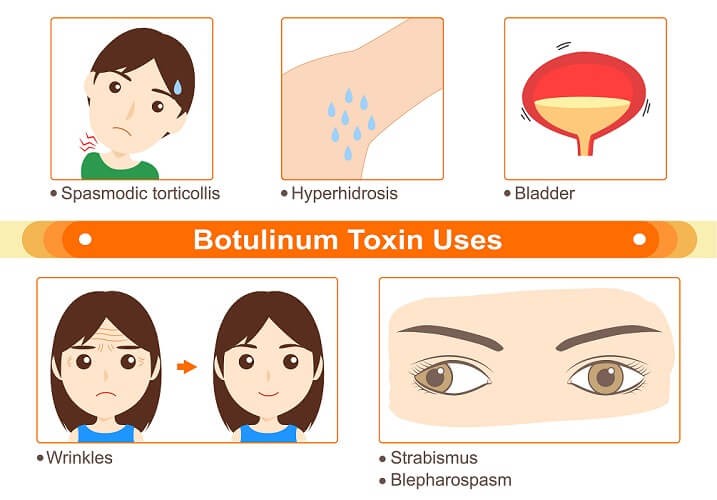
Contents
What Is Botulinum Toxin Used For?
The bacterial botulinum toxin, refined into Botox and other formulations, can smooth fine lines and wrinkles by paralyzing underlying facial muscles, reduce nerve pain, and relax spasming muscles.
Botulinum toxin, a neurotoxin produced by Clostridium botulinum bacteria, has therapeutic benefits. It works as a muscle relaxant and treats certain neuromuscular diseases, as well as smooths wrinkles caused by aging.
Crude botulinum toxin is purified and diluted with human serum albumin before use. Types A and B are currently used in botulinum toxin injections.
Researchers have discovered an eighth type named ‘H’. It is the deadliest substance of the group, with no antidote, and its DNA sequence is kept secret from public databases.
Where is botulinum toxin found?
Clostridium botulinum spores are commonly found in the soil, plants, water, and animal intestinal tracts. When the spores germinate and grow in the right environment, they produce the deadly botulinum toxin.
What is botulism?
Botulism is a rare, serious, and potentially fatal condition caused by botulinum toxin. It leads to paralysis of the muscles, including the respiratory muscles. Human botulism is caused by types A, B, E, and occasionally F.
Botulism has four types:
- Foodborne botulism: from improperly processed canned food contaminated by C. botulinum
- Wound botulism: infection of an open wound by C. botulinum
- Infant botulism: occurs when infants ingest C. botulinum spores before developing gut flora
How does botulinum toxin work?
Muscles contract when nerve terminals release acetylcholine. Botulinum toxin blocks the release of acetylcholine, preventing muscle contraction.
Botulinum toxin injections bind to nerve terminals, blocking acetylcholine release and relaxing targeted muscles.
Botulinum toxin also blocks the release of other neurotransmitters and reduces pain sensation, although the mechanism is not fully understood.
What is botulism toxin used for?
Botulinum toxin is used for cosmetic and therapeutic purposes. It is being researched for an expanding range of conditions, including pain management in chronic pain disorders.
Botulinum toxin injection is used to treat various dystonic disorders, spasticity, nondystonic disorders, chronic pain, and smooth muscle hyperactive disorders.
What are the FDA-approved botulinum toxin drugs?
OnabotulinumtoxinA (Botox, Botox Cosmetic)
Botox is approved for:
- Cervical dystonia, severe primary axillary hyperhidrosis, strabismus, and blepharospasm
- Neurogenic detrusor hyperactivity and chronic migraine
- Upper limb spasticity
- Glabellar lines, lateral canthal lines
- Upper and lower limb spasticity, cervical dystonia, glabellar lines
- Lower limb spasticity in children aged 2 years or older
IncobotulinumtoxinA (Xeomin)
- Upper and lower limb spasticity, cervical dystonia, blepharospasm, glabellar lines, chronic sialorrhea
PrabotulinumtoxinA (Jeuveau)
- Approved for moderate to severe glabellar lines.
RimabotulinumtoxinB (Myobloc)
- Approved for cervical dystonia
What are the side effects of botulinum toxin drugs?
Botulinum toxin injection is well-tolerated with mostly mild and temporary side effects. Injection site reactions include pain, redness, bruising, infection, and hematoma.
Complications from cervical dystonia treatment may include neck weakness, dysphagia, fatigue, lethargy, dizziness, dry mouth, and hoarse voice.
By clicking Submit, I agree to the MedicineNet’s Terms & Conditions & Privacy Policy and understand that I may opt out of MedicineNet’s subscriptions at any time.
Summary
Botulinum toxin, a neurotoxin produced by Clostridium botulinum bacteria, has therapeutic benefits as a muscle relaxant, wrinkle reducer, and neuropathic pain reliever. It is purified and diluted before use. Ongoing research continues to uncover new uses for botulinum toxin in various conditions.


